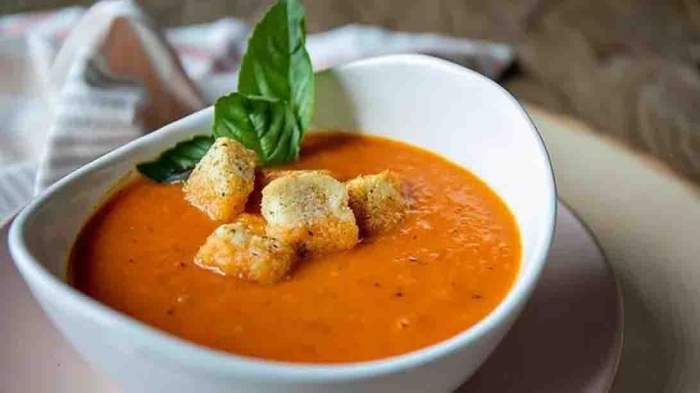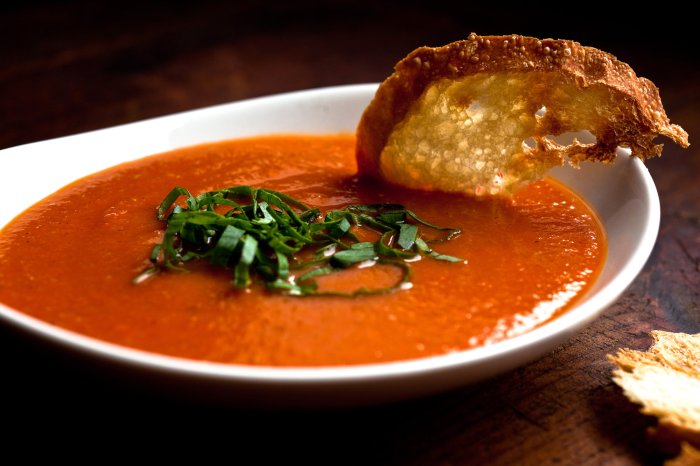Red Pepper and Tomato Soup: A Culinary Exploration: Recipe Red Pepper And Tomato Soup

Source: diyjoy.com
Recipe red pepper and tomato soup – This article delves into the versatility of red pepper and tomato soup, exploring recipe variations, ingredient considerations, cooking techniques, serving suggestions, and nutritional benefits. We will guide you through creating this classic soup, from selecting the freshest ingredients to achieving a perfectly smooth and flavorful result.
Recipe Variations: Mild, Medium, and Hot
Three variations are presented, each catering to different spice preferences. Key differences in ingredients and preparation methods are highlighted in a comparative table.
| Recipe | Spice Level | Key Ingredients | Preparation Notes |
|---|---|---|---|
| Mild Red Pepper and Tomato Soup | Mild | Fresh red bell peppers, canned diced tomatoes, vegetable broth, onion, garlic, a pinch of cayenne pepper. | Sauté onions and garlic, add peppers and tomatoes, simmer until softened. Blend until smooth. |
| Medium Red Pepper and Tomato Soup | Medium | Fresh red bell peppers, canned diced tomatoes, vegetable broth, onion, garlic, ½ teaspoon smoked paprika, ¼ teaspoon cayenne pepper. | Roast peppers and onions before adding to the pot for a deeper flavor. Simmer until softened, blend until smooth. |
| Hot Red Pepper and Tomato Soup | Hot | Fresh red bell peppers, canned diced tomatoes, vegetable broth, onion, garlic, 1 teaspoon smoked paprika, 1 teaspoon cayenne pepper, 1-2 chopped fresh jalapeños. | Roast peppers, onions, and jalapeños. Simmer with tomatoes and broth. Blend until smooth. Adjust cayenne pepper to preference. |
The mild version offers a sweet and savory base, while the medium introduces smoky notes and a gentle warmth. The hot version delivers a robust, fiery flavor profile, ideal for spice enthusiasts.
Ingredient Sourcing and Substitution
This section discusses the advantages of using fresh ingredients and offers alternatives for red peppers.
Using fresh tomatoes and red peppers provides superior flavor and texture compared to canned alternatives. Fresh ingredients offer a brighter, more vibrant taste and a firmer texture in the final soup. However, canned tomatoes offer convenience and can be a viable option, especially when fresh produce is out of season or unavailable.
Three alternative ingredients for red peppers include:
- Roasted sweet potatoes: Offer a naturally sweet and earthy flavor, creating a creamier texture.
- Butternut squash: Adds a subtly sweet and nutty flavor, resulting in a richer, more complex soup.
- Carrots: Contribute a mild sweetness and vibrant orange hue, creating a lighter, less intense flavor profile.
Tips for selecting high-quality red peppers and tomatoes:
- Choose red peppers that are firm, smooth-skinned, and brightly colored.
- Avoid peppers with bruises, blemishes, or soft spots.
- Select ripe tomatoes that are heavy for their size and have a slightly soft texture.
- Look for tomatoes with smooth skin and a deep red color.
Cooking Methods and Techniques

Source: nyt.com
This section compares stovetop and slow cooker methods and details techniques for achieving a smooth, creamy texture.
Stovetop Method: Sauté aromatics, add peppers and tomatoes, simmer until softened, blend until smooth.
Slow Cooker Method: Combine all ingredients in a slow cooker, cook on low for 6-8 hours or high for 3-4 hours, blend until smooth.
Achieving a smooth and creamy texture can be accomplished through blending or straining. Blending creates a velvety texture, while straining removes seeds and skins for a smoother, more refined consistency. Roasting the peppers prior to blending enhances the depth of flavor.
Roasted Red Pepper and Tomato Soup: Preheat oven to 400°F (200°C). Halve and deseed red peppers, toss with olive oil, salt, and pepper. Roast for 20-25 minutes, or until softened and slightly charred. Add roasted peppers to the soup along with other ingredients. Roasting intensifies the sweetness and adds a smoky depth to the flavor.
Serving Suggestions and Pairings
This section explores diverse serving options and complementary pairings.
| Serving Style | Description |
|---|---|
| Appetizer | Serve in small bowls as a starter before a meal. |
| Main Course | Serve in larger bowls with a side of crusty bread or a grilled cheese sandwich. |
| Topped Soup | Enhance the soup with toppings like croutons, cheese, or fresh herbs. |
| Soup Course | Include as part of a multi-course meal. |
Three complementary side dishes include:
- Grilled Cheese Sandwich: The classic pairing, offering a comforting contrast to the soup’s warmth.
- Caprese Salad: A fresh and light salad with mozzarella, tomatoes, and basil, balancing the richness of the soup.
- Garlic Bread: Toasted bread with garlic butter, enhancing the savory notes of the soup.
Suggested toppings include:
- Croutons
- Shredded Parmesan cheese
- Fresh basil or chives
- A swirl of cream or crème fraîche
Nutritional Information and Health Benefits, Recipe red pepper and tomato soup
This section provides a nutritional breakdown and highlights the health benefits of key ingredients.
Nutritional information (per serving, approximate values): Calories: 150-200, Protein: 5-7g, Fat: 5-8g, Carbohydrates: 20-25g, Fiber: 4-6g. These values vary depending on specific ingredients and portion size.
Red peppers are rich in vitamin C and antioxidants, boosting the immune system and protecting against cell damage. Tomatoes are an excellent source of lycopene, a powerful antioxidant linked to reduced cancer risk. Both ingredients contribute to overall health and well-being.
Nutritional Content Illustration: Imagine a pie chart. A large segment represents vitamins (C and A), another substantial segment represents antioxidants (lycopene and others), and smaller segments represent fiber, protein, and healthy fats. The chart visually emphasizes the rich nutritional profile of the soup.
FAQ Compilation
Can I make this soup ahead of time?
Yes, this soup tastes even better the next day! Store it in an airtight container in the refrigerator for up to 3 days.
Can I freeze this soup?
Absolutely! Allow the soup to cool completely before freezing in airtight containers for up to 3 months.
What if I don’t have a blender?
A vibrant red pepper and tomato soup is a delightful option for a light meal, offering a sweet and savory flavor profile. For a similar creamy texture but with a different vegetable base, you might consider trying a recipe for broccoli cauliflower soup , which offers a unique depth of flavor. Returning to our red pepper and tomato soup, remember to adjust seasoning to your preference for the perfect balance.
You can achieve a smoother consistency by using an immersion blender or carefully pulsing the soup in a food processor in batches. Alternatively, you can leave the soup chunkier for a rustic texture.
What are some other vegetable additions?
Carrots, celery, zucchini, and even sweet potatoes can be added for extra flavor and nutrients.
